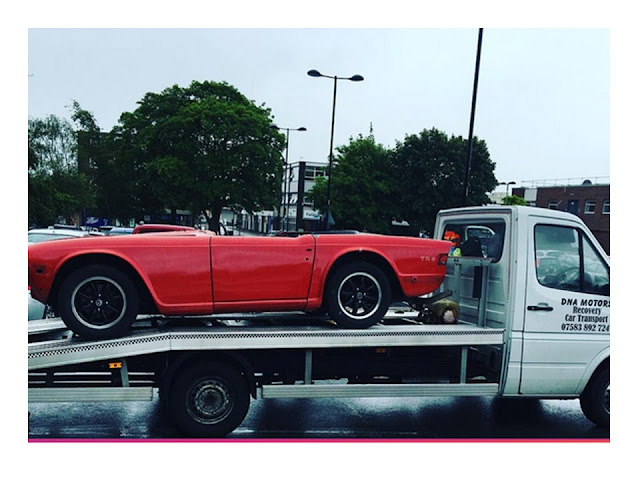So, as the car is being pretty much totally disassembled for the respray I thought it would be a good time to rebuild the heater. After all it is pretty much "buried" deep behind the dash and my heater motor had been droning for a while. So job one... remove the heater. this entails.
1) removing a load of stuff that is under the dash
2) disconnect the cable from the heater control on the dash
3) disconnect the heater pipes (air and water). Beware of flooding the footwell with water!
4) unbolt the 4 bolts that attach the heater to the firewall..
Simple! or perhaps not.. all went well until stage 4 and then 2 of the bolts (that point upwards and attach to captived nuts "inside" the upper part of the fire wall sheared. Bu^&er! Deep breaths!! will sort that later.
withdrew the heater from under the dash and had a look at it.
As you can see it is not really what's called high tech. It is essentially a biscuit tine with pipes coming out of it. Two small ones for water and 4 large ones for air (you can only see 2 in this picture). The lower one is cold air (it is before the heater matrix) and the upper one on the right is hot air (after the heater matrix). There is also a motor (hidden under the dome on the left) and a flap on the right which (in theory controls where the air goes). I continued to take it apart (fairly easy if the self tapping screws that hold it all together are not rusted up!)
And heres's the motor (two speed) and fan. Now I knew the motor was a bit iffy and there was certainly some play in the bearings. So I looked at the price of a new one and had to sit down "how much!!".. to calm down I did a bit of trawling of the internet and found some inventive people across the pond had found a cheaper equivalent motor. Where did they find it? from a school bus of course!
Link to alternative TR6 heater motor. It has the same shaft diameter as the Lucas one in the TR. is two speed but without the external resister found on the TR version.. and best of all it was less that £20. Only issue would have been shipping, but I was working in the US in the next few weeks. So here it is in comparison to the Lucas item.

You'll see the size is about right. Note there is no shaft on the lucas one (left) as I had to cut it off to get the fan off. The only thing that is missing is the mounting flange. However I managed to rig one up using in jubilee clip (that was large enough to go around the complete motor body) and then a set of small "L" shaped brackets. Works great.
then connect to a battery for a test and wow.. what a difference.. the motor is smooth and silent and the power... amazing!
Next I stripped all the old paint and rust from the "biscuit tin" and then reassembled including new bits of foam around the heater to ensure that the maximum amount of hot air goes through and not around the matrix. (I use closed cell foam which comes on a roll for going under laminate floors, its cheap and self adhesive).

The final piece in the heater jigsaw is the heater flap. In theory I think the idea is that in one position the flap (and its foam backing) shut off air going through the heater forcing all the air (cold) out of the dash vents. In a second position the flap uncovers the pipes on the hot air side allowing air to flow to the demist and under dash vents. I think there is a third position (or at least there was in mine) with the flap fully down and poking out of the "biscuit tin". In this position the hot air was directed out of the bottom of the heater to the feet. All great in theory but position one didn't work because the foam had disintergrated (so new foam) and position 2 wasn't great as their were large gaps around the edge of the flap. This meant that the demist (perhaps the most important function was awful!).
So what to do... With a bit of lateral thinking I came up with a solution... draft excluders.. cheap (99p) and a MUCH better seal. I just cut them to size and riveted them in place.
Now all I have to do is refit.... But hang on... not so fast.. remember I had sheared two of the bolts that hold the heater in. you can see one of the offending studs pretty much below (the rusty patch on the front edge of the circular hole.
This is not going to be easy to drill out... So how about an easier strategy... weld in some replacement studs
Will need to tidy the welds.. but problem solved.




















